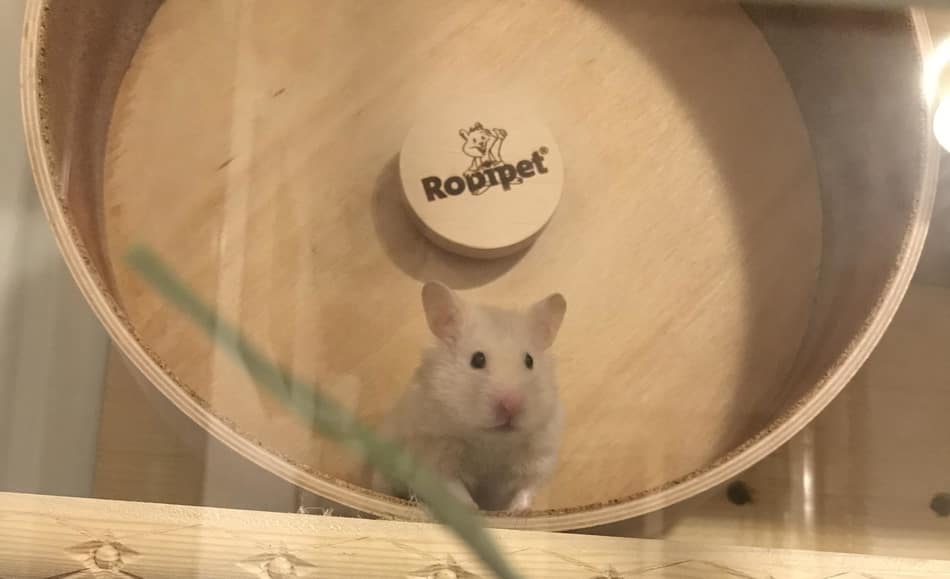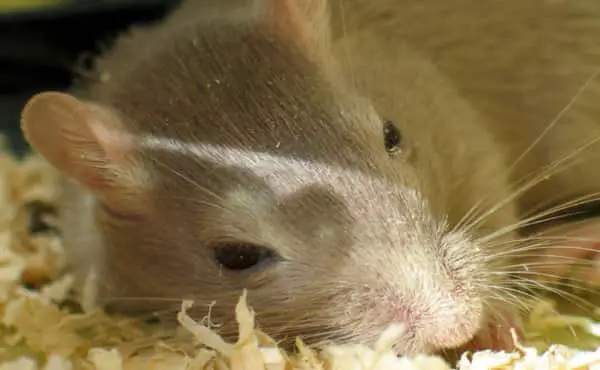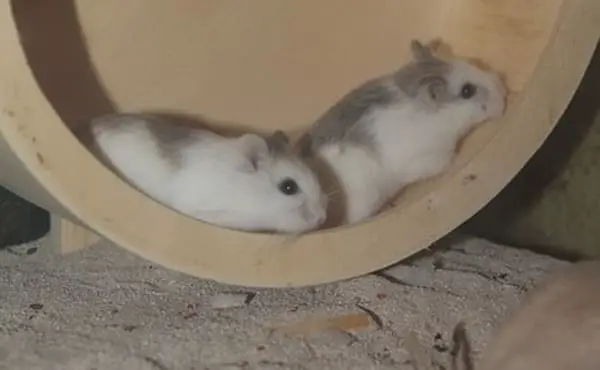For those of us who share our homes with a hamster, observing new and odd behaviors is nothing out of the ordinary. However, that does not keep us from worrying about some of these behaviors, such as a hamster lying on its running wheel. It is always best to get as much information as possible when determining the cause of a new behavior in your furry friend.
So, why is my hamster lying on his wheel? The most likely reason is because your hamster feels it has no other suitable areas in which to sleep. There are a few other possibilities, circumstances depending, some of which could require intervention on your part.
In this article we will discuss the importance of having lots of safe, clean hides in an enclosure, the surrounding environment, and how illness possibly drives this behavior. We will also cover hamster personalities and preferences.
Hide and Go Sleep
In the wild, hamsters are natural burrowers. They live in dry, arid regions such as deserts and steppes, and are often subject to extreme temperatures and predation. Because of this, they dig burrows consisting of multiple interconnected rooms and tunnels in which they sleep, store food, and raise their babies among other things.
They spend most of their time in their burrows, safe from predators and extreme heat and cold, with lots of food and comfort.
Our homebound hamsters, cousins of these wild creatures only removed by about a century, still have strong burrowing instincts, even in temperature-controlled, predator-free homes. This strong instinct drives our domestic friends to burrow and seek comfy shelter like what they would have in the wild.
This means that hamsters in our homes need lots of places to dig, such as dedicated boxes or extra layers of substrate or “bedding,” and lots of places to hide so they can sleep, store food, and eat in spaces they feel are safe and secure.
If your furry friend has no place like this to which they can retire, they might perceive their wheel as the only place they can rest. You can be sure this is the case if your hamster also stores food and bedding material on the wheel.
Even if you do have a hamster hide in your enclosure, one place is often not enough, since hamsters are accustomed to having intricate tunnels connecting multiple rooms as mentioned above. Your furry friend may prefer to sleep in one room, store food in another, and have another one for extra bedding and burrowing and so on.
Further, it is important to ensure these hides are cleaned out regularly and are easily accessible for small or aging hamsters. Many hamsters will not use a hide if it is too dirty. Additionally, if your pal in its golden years, put everything on the same level as it might have trouble reaching higher hides it has to climb up to for access.
For smaller dwarf breed hamsters, make sure hides do not require jumps or long steps. If your hamster cannot access its hides, it may be using the wheel instead. While laying on its wheel because of a lack of hiding spots may not be an immediate concern, it will benefit your hamster’s overall wellness in the long run to add more “rooms” to your friend’s habitat.
If your pal has plenty of places to sleep, hide, and otherwise be a hamster, the temperature in its environment may be compelling it to engage in unusual behaviors, such as the curious phenomenon of a hamster sleeping on its wheel
Is It Hot in Here?
While wild hamsters inhabit some extreme climates in the wild, like hot deserts in Syria or frigid steppes in Mongolia, they often do not have to experience the brunt of those extremes, since they are nocturnal and spend most of their time underground.
Hamsters do not possess much of an ability to regulate their body temperature, but they are quite skilled at using materials in their environment to help them. When it is too cold, our clever friends will pack nesting material around themselves to snuggle into for warmth deep down in their burrows.
Additionally, when temperatures begin to rise too much, their cool, underground digs offer welcome respite from the heat. However, hamsters adjust to cooler temperatures more easily than to extreme heat, making them susceptible to temperature-related issues such as heat stress or heat stroke.
If your furry friend has recently taken to lying on its wheel and seems lethargic and/or has been drinking much more water than usual, it might be suffering from heat stress.
Make sure the environment in which your hamster lives is dry and between 65- and 75-degrees Fahrenheit and do not place the enclosure near windows that might let sunlight beam directly onto your pal. If it is too warm or humid in your pet’s environment, it likely is lying on its wheel in an effort to cool down.
Give your furry friend extra water and place its enclosure temporarily in the coolest location in your home while you adjust the temperature in its room. In addition to lethargy and increased water intake, be aware of other heat stress and heat stroke signs like these:
- Decreased appetite
- Sudden weight loss
- Lying flat and limp on the stomach
- Wet or greasy-looking fur
If your pet is exhibiting these symptoms, cool it down by misting it lightly with room temperature water (cold water might reduce its body temperature too much, causing other issues), blowing on it or fanning it, or letting it lay down on a damp towel. Take your hamster to the vet right away if you suspect heat stroke.
If your pal lives in a temperate room with lots of places to hide, sleep, and store food, but still lays on its wheel, it might be showing signs of illness.
Under the Weather
For being so small, hamsters are robust little creatures. After all, they inhabit some of the harshest climates in the world. However, when they do become ill, their small stature means that things can escalate quickly if not caught early enough.
If you have observed your furry friend lying on its wheel without outside factors like heat or lack of hiding places driving the behavior, you should rule out illness as soon as possible.
Hamsters are especially susceptible to respiratory issues and digestive trouble, so be on the lookout for sneezing, wheezing, or discharge from the eyes or nose, as well as wetness around the tail or diarrhea. Additionally, a ruffled or unkempt coat, general lethargy, and loss of appetite are also red flags of illness.
Look for these signs if your pet has only recently started lying on its wheel, as uncharacteristic behavior of any kind is another indicator that something is amiss. Schedule a visit with your furry friend’s veterinarian as soon as you can to get them checked out and back on their feet so you can enjoy each other’s company again.
Illness aside, if you have read this far and still cannot make sense of your pocket-sized pal’s odd behavior, it might simply be a personal preference.
They Like What They Like
Hamsters, just like any other critter, have their own unique personalities, and show us those personalities in a litany of ways. Some hamsters love being picked up and snuggled while others prefer to enjoy your company from a distance.
Some revel in climbing while others prefer burrowing. Some hamsters like to sleep cuddled up in a small, dark space, while others, perhaps like yours, want to sprawl out on their wheel.
Provided your friend is happy and healthy with a properly sized wheel, your hamster may simply enjoy relaxing there. (Side note: wheel size is important, as a too-small wheel could cause discomfort while running and compel your friend to only use it for lounging.
Make sure your wheel is at least 6.5 inches or larger for dwarf breeds and 8.5 inches or larger for Syrians.) Some hamsters even like to lay on top of their wheel, or between their wheel and their enclosure wall.
It all boils down to what your furry friend favors. Furthermore, most hamsters simply enjoy having a wheel—in some studies, even wild hamsters will take to a wheel when given the opportunity. Perhaps your friend is simply spending as much time as it can enjoying its favorite toy.
Conclusion
If your pocket-sized pal has taken to lying on its wheel, chances are it does this because it feels it has no other suitable areas to relax, and you might observe the quirky behavior of a hamster sleeping in the wheel. As natural burrowers, hamsters need lots of places to hide, store food, and feel safe. If hiding places are not the issue, perhaps the temperature is the problem.
Hamsters need a consistently dry, temperate area to inhabit, so make sure your friend’s living quarters do not feel tropical as heat stress and heat stroke are dangers for our little friends. Temperature issues aside, if laying on its wheel is new behavior, illness could be the culprit.
Always make sure to be familiar with common hamster ailments and symptoms so you can catch it right away, as some conditions can turn serious very quickly for our tiny pals. Finally, as with any creature, hamsters have different personalities and preferences.
Yours could have discovered that the wheel is just a great place to lay on and has decided that is what it wants to do. In any case, if you are vigilant about keeping your furry friend happy and healthy, there is no cause for concern, so continue to enjoy your tiny friend’s antics in peace.





